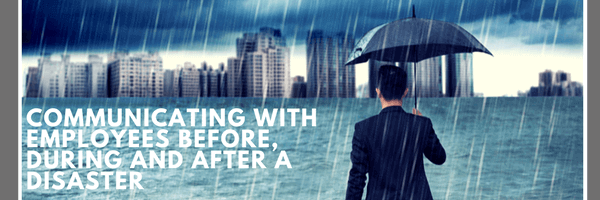Post Date: 09/20/2017
What is HR’s role in disaster preparedness?
With the catastrophic flooding of Harvey in our rear-view mirror, Houstonians are now turning their attention to the formidable task of recovery and rebuilding. Although it may be tempting to believe that something like Harvey will never happen again, emergencies and disasters are inevitable. For business organizations, preparing for such eventualities can mitigate damages, speed recovery and even save lives. In recent weeks, HR Directors have been faced with developing a broader understanding of their role in disaster planning and a workplace emergency.
A workplace emergency is any unforeseen situation that threatens your employees, your customers or the general public. The emergency can be localized to your place of business, disrupting or shutting down your operations, or it can be widespread physical or environmental damage. Emergencies may be natural or manmade and include catastrophic weather events, earthquakes, fires, toxic gas or chemical spills, explosions, civil disturbances and workplace violence just to name a few.
Post-disaster, most business owners, typically want to get operations back up and running quickly. It is understandable as every delay can have a negative impact on the well-being of the company, and therefore its employees. However, companies must understand that it isn’t always possible to return to business as usual after a major catastrophe. Having a specific plan of action before, during and after a crisis can make the transition back to normal operations smoother for everyone involved.
Before the Emergency: Have a plan before you need one
Having a plan in place before an emergency happens is, by far, the best approach to managing a disaster. Few people can think clearly in a crisis, so it is important to create a plan before you need one. An emergency action plan provides designated actions employers and employees must take to ensure safety in the event of an emergency. Most employers are required by OSHA to establish an emergency action plan for the worksite. Developing a tailored plan means you should conduct a hazard assessment to determine if any physical or chemical hazards in your workplaces could cause an emergency. If you have more than one worksite, each site should have an emergency action plan. Invite staff participation and organize key employees to develop and maintain preparedness programs. For OSHA guidelines on Emergency Action Plans, read here: https://www.osha.gov/SLTC/etools/evacuation/eap.html
During the Emergency
In the event of a disaster during work hours, how will employees throughout your building or work site be notified? Identify communication methods appropriate to your staff such as a public address system, text or voice messages, social media or even apps. Build redundancy in your crisis notification system to ensure that information is distributed to the entire workforce. Employees must know where to check in after an evacuation to ensure that everyone is present. Having a system in place, communicating it to employees and practicing the check-in procedure will ensure a safer evacuation in the event of a major crisis.
If the emergency occurs off-site or after work hours, have a call tree prepared to make sure that everyone in the organization is contacted, notified of the incident and plan. Call trees can play an important role in disaster recovery plans with automated with software that reaches staff or clients, using a landline, email, cell phone, text message or another method of communication. Smaller organizations might prefer a manual call tree where each person who receives a call is responsible for calling others in the tree. Each listed employee should have several methods of contact, including home phone, cellphone, and email address. The up-to-date emergency call tree should be available in both digital and hard copy formats in several locations. Social media, company websites or intranet, can also be used to establish contact with all employees.
After the Emergency
When a business is impacted by a disaster that causes a temporary shutdown or slowdown of operations, employees will be primarily concerned about their job security. If a disaster impacts the employees’ homes and possessions, they may be most concerned with basic needs such as shelter, clothing, and food. Clear and frequent communication regarding the recovery process, the status of operations and assistance available to employees will make the transition back to work easier for workers and the organization alike. A quality Employee Assistance Program can provide counseling and assistance to your employees. Employees should be reminded of plan benefits and how to schedule appointments.
At VIP Staffing, we are committed to the recovery effort and grateful to be open and servicing our clients’ needs. #HoustonStrong











